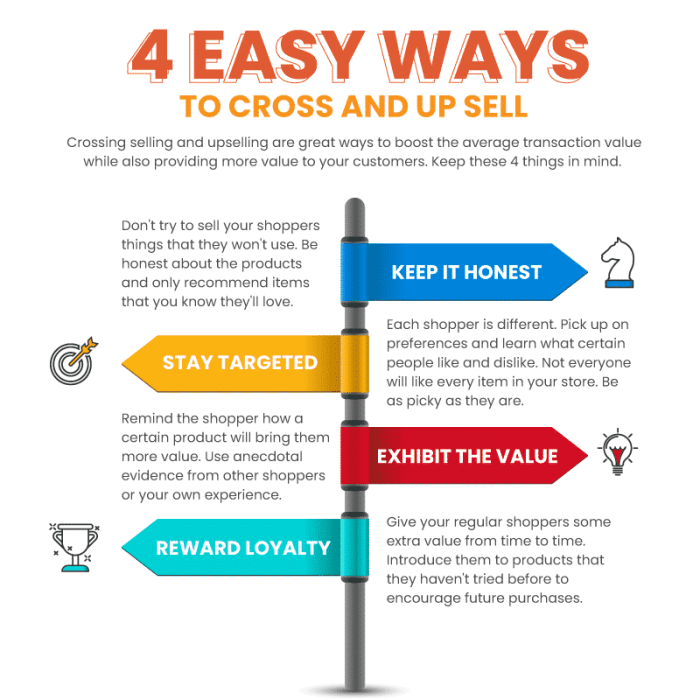Cross-Selling Techniques: Get ready to dive deep into the art of boosting sales through strategic upselling. From understanding customer behavior to implementing cutting-edge strategies, this topic will take you on a thrilling ride through the world of cross-selling.
Uncover the secrets behind successful cross-selling and discover how businesses leverage this technique to maximize profits and customer satisfaction.
Introduction to Cross-Selling Techniques
Cross-selling is a sales technique where a company sells additional products or services to an existing customer. It involves offering related or complementary items to the customer based on their initial purchase or interests.
For businesses, cross-selling is essential as it not only increases revenue but also enhances customer satisfaction and loyalty. By understanding the needs and preferences of customers, businesses can provide personalized recommendations that add value to the customer’s overall experience.
Successful Cross-Selling Strategies
- Amazon: Amazon utilizes cross-selling effectively by recommending related products to customers based on their browsing and purchase history. For example, when a customer buys a laptop, Amazon suggests accessories such as laptop cases, mouse, and headphones.
- Starbucks: Starbucks implements cross-selling by suggesting food items like pastries or sandwiches to accompany the customer’s coffee order. This strategy increases the average order value and enhances the overall customer experience.
- Apple: Apple showcases cross-selling by offering additional services such as AppleCare and iCloud storage when customers purchase a new iPhone or MacBook. This not only generates extra revenue but also ensures customer satisfaction by providing comprehensive support.
Understanding Customer Behavior

Customer behavior plays a crucial role in the success of cross-selling techniques. By understanding how customers think and make decisions, businesses can tailor their strategies to effectively promote additional products or services. Leveraging psychological principles and customer data can significantly enhance cross-selling efforts.
The Influence of Customer Behavior
- Customers are more likely to make additional purchases when they feel a sense of trust and satisfaction with the initial product or service.
- Understanding customer preferences and buying patterns can help businesses identify opportunities for cross-selling.
- Emotional triggers, such as fear of missing out or the desire for convenience, can influence customers to consider complementary products.
Psychological Principles in Cross-Selling
- Reciprocity: Offering customers something of value before asking for a sale can increase the likelihood of them making a purchase.
- Social Proof: Highlighting how other customers have benefited from cross-selling can build trust and encourage new purchases.
- Scarcity: Creating a sense of urgency or limited availability for complementary products can drive customers to act quickly.
Leveraging Customer Data for Cross-Selling
- Utilizing purchase history and browsing behavior can help businesses personalize cross-selling recommendations for individual customers.
- Analyzing demographic information and past interactions can provide valuable insights into customer preferences and interests.
- Implementing data-driven strategies, such as predictive analytics, can anticipate customer needs and offer relevant cross-selling opportunities in real-time.
Implementing Cross-Selling Strategies
Implementing cross-selling strategies involves a systematic approach to maximize opportunities and enhance customer satisfaction. By effectively identifying cross-selling opportunities and leveraging technology, businesses can increase revenue and build stronger customer relationships.
Step-by-Step Methods for Implementing Cross-Selling Techniques
- Understand the customer’s needs: Take the time to analyze customer behavior, preferences, and purchase history to identify potential cross-selling opportunities.
- Train your sales team: Provide training and resources to your sales team to effectively communicate and offer relevant cross-selling products or services to customers.
- Create personalized recommendations: Use customer data and insights to create personalized recommendations for cross-selling offers tailored to each individual.
- Monitor and analyze results: Regularly track the performance of cross-selling strategies, analyze results, and make adjustments as needed to optimize outcomes.
Tips on How to Identify Cross-Selling Opportunities
- Utilize customer data: Leverage customer data and analytics to identify patterns and trends that indicate potential cross-selling opportunities.
- Listen to customer feedback: Pay attention to customer feedback and inquiries to understand their needs and preferences, which can help uncover cross-selling possibilities.
- Offer complementary products/services: Identify products or services that complement each other and present them as cross-selling options to customers.
The Role of Technology in Enhancing Cross-Selling Strategies, Cross-Selling Techniques
Technology plays a crucial role in enhancing cross-selling strategies by enabling businesses to streamline processes, personalize recommendations, and track customer interactions. With the use of advanced analytics, CRM systems, and AI-powered tools, businesses can optimize cross-selling efforts and deliver a seamless customer experience.
Cross-Selling Best Practices: Cross-Selling Techniques

In the world of cross-selling, there are certain practices that can help maximize results and drive success. By understanding and implementing these best practices, businesses can effectively increase revenue and enhance customer satisfaction.
Personalized Recommendations
- Offer personalized product recommendations based on the customer’s past purchases or browsing history.
- Use data analytics to understand customer preferences and tailor cross-selling offers accordingly.
- Implement AI-powered recommendation engines to suggest relevant products in real-time.
Strategic Bundling
- Create strategic product bundles that offer value to the customer while increasing the average order value.
- Promote bundle discounts to incentivize customers to purchase complementary products together.
- Highlight the benefits of buying bundled products to showcase the value proposition.
Omnichannel Approach
- Utilize multiple channels such as online, mobile, social media, and in-store to reach customers with cross-selling offers.
- Ensure a consistent and seamless experience across all channels to enhance customer engagement.
- Track customer interactions across channels to provide targeted cross-selling recommendations.
Case Studies
Amazon
Amazon excels in cross-selling by leveraging its vast customer data to offer personalized product recommendations. Through features like “Frequently Bought Together” and “Customers Who Bought This Item Also Bought,” Amazon drives additional sales by suggesting relevant products to customers.
Netflix
Netflix implements a strategic bundling approach by offering different subscription plans based on customer preferences. By recommending personalized content based on viewing history, Netflix effectively cross-sells additional services like premium memberships and add-ons.
